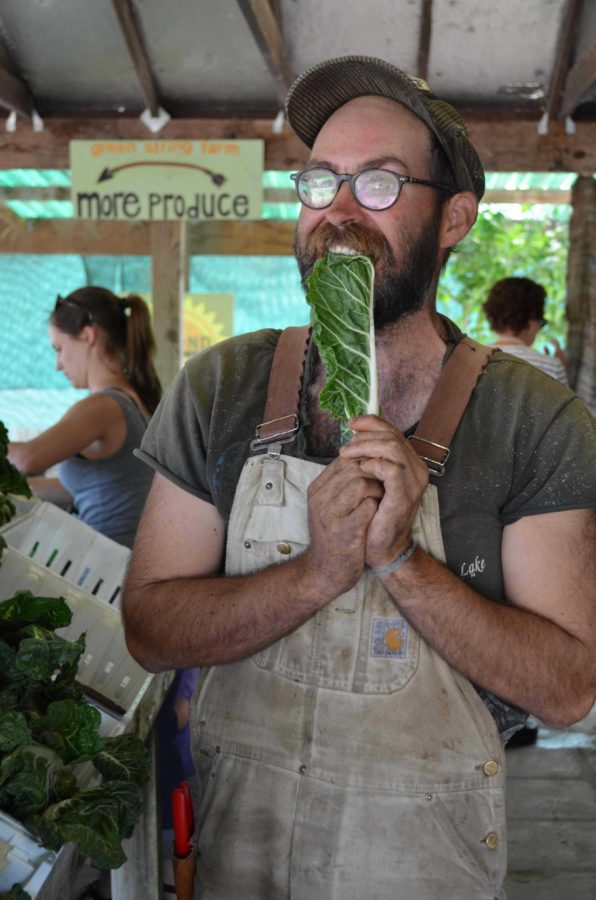The familiar hiss of rushing cars affirms the presence of nearby cities and towns, but the sound is faint to volunteers who have made the short commute to another landscape. Rows of mounded earth give way to rooted green masses carrying an edible assortment of oranges, yellows and reds. Perhaps it’s the intoxicating smell of composted earth, or maybe it’s the nourishing effect of the sun, whatever the exchange, these micro jungles have become host to a handful of eager students, community members, and resident interns seeking something beyond monetary gains.
Motivated by environmental, economic and social stresses on resources, communities have decided to actively reconnect with one of the most basic human needs: food. The back-to-the-land movement’s recent resurgence provides aspiring backyard gardeners, farmers and community volunteers with a range of opportunities for involvement.
According to the Sonoma County Food System Alliance, communities are increasingly turned to farmers markets, community supported agriculture (CSA) and community gardens to access fresh produce. In Sonoma County the number of community gardens increased from 30 to 43 between 2009 and 2010.
FOOD ACCESS
“At Slide [Ranch] I learned that a really effective way to initiate change or environmental change in someone is through food because food is a daily choice for a child and a family,” said Connor Maguire, 29, of his Teacher-in-Residence internship at Slide Ranch of Marin.
Now on his second season at Green String Farm, this time as paid staff, Maguire embodies the basic philosophy at Green String: nouveau naturalism. “We grow here specifically 50 percent for humanity and 50 percent for nature, realizing that everybody wants lunch,” he said.
Green String Institute interns share a living space with their colleagues and are provided a small stipend. Meals are shared and class convenes promptly at 1:30 p.m. As soon as one group of interns exits the program the next group enters.
Bob Connard, founder and director of the Green String Institute, shares his dream with his students every season. Connard imagines a coalition of urban tea gardeners, selling herbs off of tea carts, “pushing them around, out-selling Starbucks.”
“The star police,” Maguire added with a grin.
The plot stems from a larger vision to enlist a Green String Certification that requires a more transparent grower-consumer relationship. The term organic is a classification by omission and “has kind of been hijacked and bureaucratized,” said Maguire.
COMMUNITY
Founded in 2006, Petaluma Bounty offers interns and volunteers a more direct approach to addressing food security. At just 2.5 acres the harvest feeds a subsidized Community Supported Agriculture (CSA) program, the Petaluma Health Center’s Thursday Market and a handful of local restaurants.
The Bounty Community Farm relies heavily on volunteer participation. “It’s like the community is helping the farm get it out to other communities,” said Joella Simons Adkins, 24, who was offered the assistant farm manager position through volunteering.
Last Wednesday, October 1, the group included two volunteers who had been coming for years, a recently established regular, and two students fulfilling a two-hour class requirement.
“You need support one way or the other, whether it’s borrowing a tractor or getting help digging something,” Adkins said.
“Newly available resources for farmers like the Heirloom Exposition and Farmer’s Guild offer small-scale farmers additional, essential infrastructure,” Adkins said.
“I like that it’s community-oriented, and it’s moving towards a more sustainable world on a larger scale,” said Anthony Novero, 19, an environmental studies student at Sonoma State University.
EDUCATION
Volunteer opportunities complimenting tuition-based programs often encourage an atmosphere that appeals to both new participants and those seeking a more advanced farming repertoire.
The Occidental Arts and Ecology Center (OAEC) is a nonprofit with an educational mission and attracts an elite group of career gardeners and farmers interested in absorbing 30-something years of farming experience from “Doug-O.” Doug Gosling, a founding member, co-teaches the OAEC’s Permaculture and School Garden courses and manages the greenhouse, orchard, and garden.
Leith Carstarphen, owner of EcoLogic landscaping, returns to the OAEC’s weekly volunteer day for the exposure to new plant varietals.
“It’s expanding my education a little bit. Also, just re-inspiring,” Carstarphen said.
Additional resources for the aspiring landscape and farming entrepreneur can be found at the Permaculture Skills Center of Sebastopol where Anson Biller managed the farm since it opened in 2012.
Biller said the center was built around a microenterprise model, similar to Polyface Farms of Virginia. Under the model, Biller explained some apprentices or interns elect to stay on the property and create their own enterprise, the Skills Center currently offers two courses of study that result in certification.
While nonprofit status pends, Biller hopes to expand their CSA program to 60 members.


